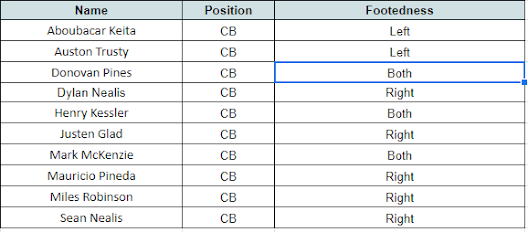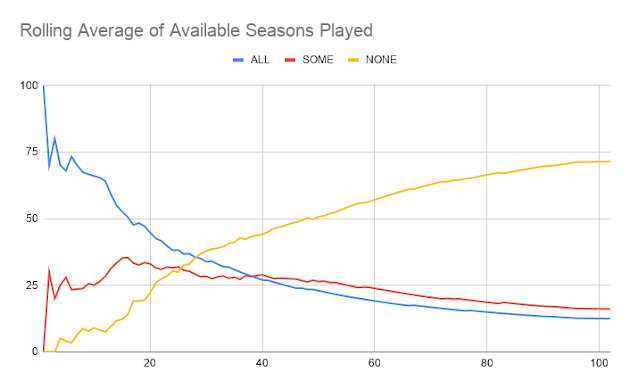US Olympic Qualifying Deep Dive Pt.2- The Center Backs
The foundation of any successful team is in the back, with the center backs and fullbacks. The Berhalter system has used overlapping fullbacks, as well as fullbacks the fill the midfield space and allow a central midfielder to push further up the field in possession. The center backs are expected to contribute to the buildup, but the chief impetus of progress in possession is a defensive midfielder such as Michael Bradley or the U-23 eligible Jackson Yueill. Whether that is a set in stone approach based on coaching philosophy, or based on the lack of individual on-ball ability in the player pool remains to be seen.
Also, an important note: the challenge of using numbers to evaluate soccer players, especially defenders, is how to properly rate them when they are not interacting with the ball. That said, an effective USA team at the CONCACAF level is not going to be forced into many positions where the individual defending ability of a player is of primary importance. The defensive performance of the USA will be predicated on how little it allows the opposing team the ball.
The Centerbacks:
In a possession based system, the center backs are extremely important. They are expected to begin the play and confidently pass the ball in order to disorganize a press or to move the ball rapidly from side to side against a compact defense.
In most possession dominant teams, there will be both a left footed and right footed CB. In brief, this allows the defense to split the field into two and for the ball to be distributed across the field from the defense. There’s much more to it than that, but a priority for the USA will be to have an effective center back tandem.
When the USA is in possession of the ball, progressive passing is going to be key. A progressive passer is one that can push the ball up the field on a frequent basis. The following graph shows the progressive distance per completion as well as which of the CBs are the most prolific and successful in their passing in general.
In Possession
Interestingly, Justen Glad seems to be the most progressive passer in the pool. When Trusty completes passes they go downfield, but his completion rate is unimpressive and would not work well within a possession system. Mark McKenzie is getting a great deal of the press, and showed his passing ability in the last U20 cycle, but in MLS he has been average at best in progressive passing. Miles Robinson combines high accuracy passing with an ability to push the ball down the field, and does it frequently.
Another area Robinson excels is in possession of the ball. He’s a touch dominant CB with more than 70 touches per 90, in the top 10 for all MLS CBs. As CBs touch the ball more they tend to make positonal errors (misplayed passes or lost balls to defenders) more frequently; Robinson bucks the trend. Mauricio Pineda and Aboubacar Keita make mistakes at the same rate per touch and only Henry Kessler and Sean Nealis make notably fewer. Of course, Nealis and Kessler touch the ball 25% less and rarely carry it forward. Donovan Pines makes a remarkable number of errors for the number of touches he has, and almost never moves the ball forward by carrying it.
Out of Possession
Defensively there are two key dimensions for CBs. Aerial ability is obviously important, though it depends on the way the opponent plays. Another area is direct defensive actions, defined as pressing the ball carrier or attempting to tackle them. A successful defensive action is when the result in the short term is the defensive team regaining possession. Most defensive actions are not successful by that definition, so instead of looking at the number percentile rank among MLS defenders is more instructive.
There is a huge divide between the successful defenders and the unsuccessful defenders, even if the number of actions is fairly similar. Kessler and Pineda are the most successful defenders, and Keita does well even if he is not an aggressive defender. McKenzie and Robinson do well enough that their defensive work is not a major concern; they still grade in the upper quarter of MLS defenders.
The Nealis brothers each perform very well in the air, with Sean frequently being involved in duels and Dylan scoring the highest in percentage of duels won. Robinson pops up near the top of the charts again and Donovan Pines separates himself from the rest of the field in this area. The frequency that Trusty finds himself in losing aerial battles is a major concern as a CB.
Putting it all together:
The CB depth is surprisingly good, and there are some close calls to make. If Kreis is dogmatic about having a left footed CB in the system, his best choice is probably Keita, but if he does that he will need a more aggressive partner in both attack and defense. Robinson has the fewest weaknesses of any potential partner, and though he isn’t a particularly progressive passer he makes few mistakes.
In reserve, a passer who is strong with both feet and defensively will be key. McKenzie seems like an obvious choice who can comfortably play both sides of the pitch. Henry Kessler has been excellent defensively and deserves a look.
Past those 4 it’s hard to look past Pineda’s all around game. Glad’s defensive work is concerning, and Pines doesn’t do much for his team aside from aerial duels. If injuries or player availability is a concern they can get the job done, even though they are not first choice.


Comments
Post a Comment